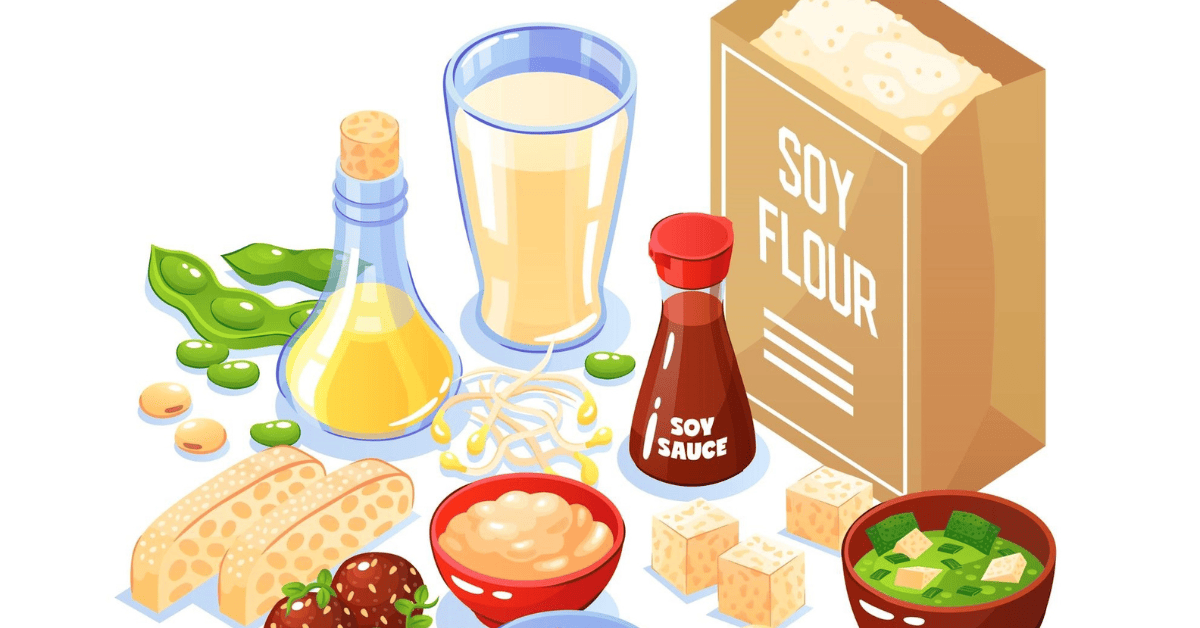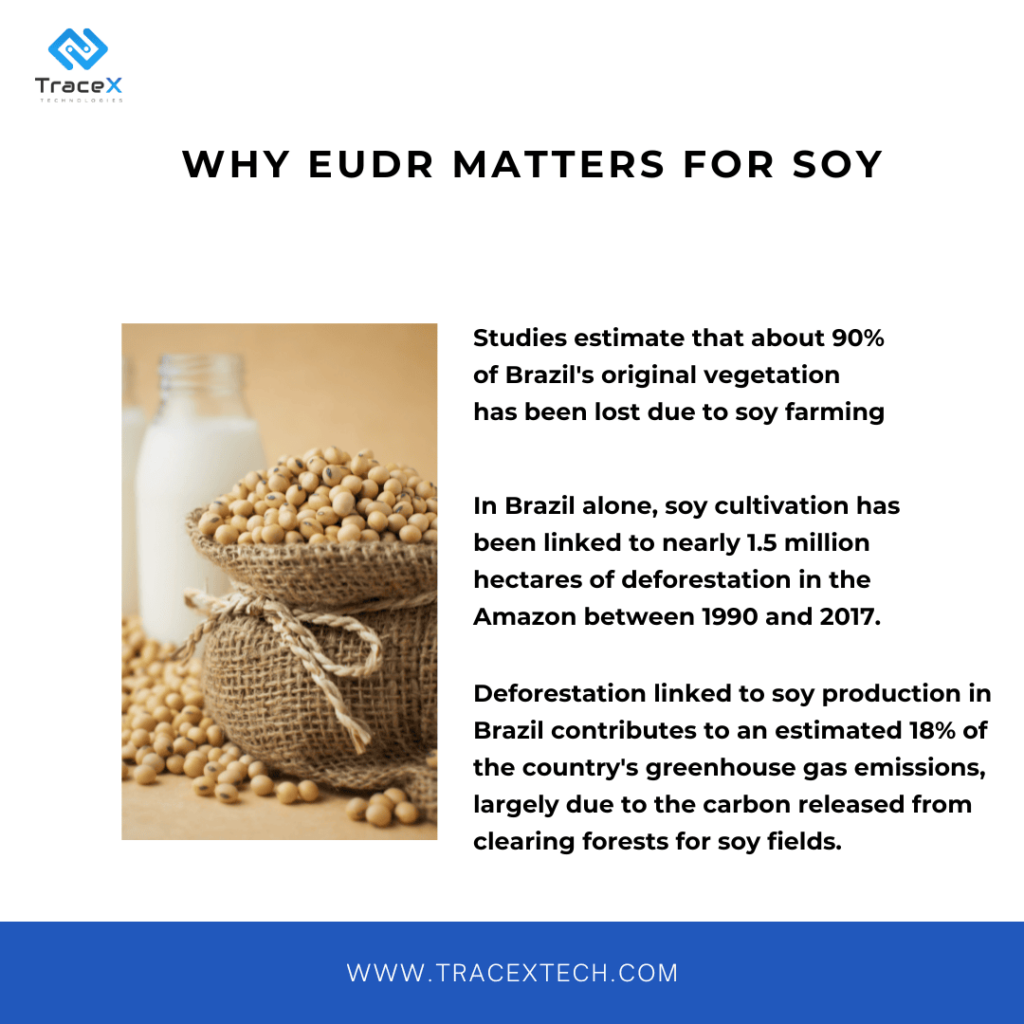Contact: +91 99725 24322 |
Menu
Menu
Quick summary: Discover essential insights into EUDR compliance for soy sourcing. Learn how to navigate regulations, enhance traceability, and promote sustainable practices in your supply chain.

Did you know that the global demand for sustainable sourcing has skyrocketed in recent years? As consumers become more environmentally conscious, businesses are under increasing pressure to ensure their supply chains align with sustainability goals. One regulation that has been making waves is the EUDR—the EU Deforestation Regulation, particularly concerning EUDR soy.
According to WRI, The Cerrado biome, a tropical savannah situated southeast of the Amazon, saw a 6% rise in tree cover loss from 2022 to 2023, maintaining a five-year upward trend. This region is the hub of agricultural activity in the nation, with its soy production more than doubling in the last two decades.
Navigating the complexities of EUDR compliance can be daunting. Many companies are struggling to adapt their sourcing strategies to meet these new requirements while also managing the inherent risks associated with deforestation. If you find yourself grappling with questions like, “How do I ensure my soy supply chain is compliant?” or “What steps should I take to source sustainably without sacrificing profitability?”—you’re not alone. We’ll break down the essential insights you need to understand EUDR soy, tackle compliance head-on, and achieve sustainable sourcing that meets both regulatory standards and consumer expectations
Key Takeaways
EUDR is the EU’s latest effort to combat global deforestation. It mandates that companies importing certain commodities into the EU must prove that their supply chains are deforestation-free. This regulation covers major agricultural products, including soy, palm oil, beef, cocoa, and more. The idea is simple: prevent soy deforestation by ensuring that supply chains are sustainable and transparent.
Soy is under the spotlight because it’s one of the key drivers of deforestation, particularly in regions like the Amazon, Cerrado, and Gran Chaco. These areas are often cleared for soy plantations, which has significant environmental consequences.
Soy supply chains play a crucial role in the global food system. It’s used in animal feed, food products, biofuels, and various other industries.
In fact, more than 75% of the world’s soy production is used for livestock feed.
As the demand for meat increases, so does the demand for soy, often leading to more deforestation. With soy playing such a vital role in the food system, ensuring that it’s sustainably sourced is crucial. EUDR compliance makes it mandatory for companies to trace their soy supply chains back to the source to prove that their products do not contribute to deforestation.

1. Traceability: Companies need to provide traceability data that shows the exact origin of the soy being imported. This includes mapping the supply chain back to the specific farm or plantation where the soy was grown.
2. Due Diligence: Businesses must conduct due diligence assessments on their suppliers to ensure that their soy is sourced from deforestation-free areas. This involves risk assessments, supplier evaluations, and continuous monitoring.
3. Reporting and Documentation: The regulation requires companies to provide detailed reports on their supply chains, which must include evidence that their soy was not sourced from deforested land.
4. Supplier Contracts: To ensure compliance, businesses should update their supplier contracts to include EUDR-specific clauses, which hold suppliers accountable for meeting the regulation’s standards.
While EUDR aims to improve sustainability, it also presents some challenges, especially for companies dealing with complex, multi-tiered supply chains. Below are some key challenges and how to address them:
Soy supply chains are often long and involve multiple intermediaries, making it difficult to track the product back to its source. For example, soybeans might be sold to several processors before ending up in the final product, complicating traceability efforts.
Invest in advanced technologies like blockchain for better supply chain visibility. These technologies can offer real-time tracking and ensure the integrity of the data being reported.
Suppliers may not always be forthcoming about where their soy is sourced. This lack of transparency makes it difficult for companies to verify whether their soy is truly deforestation-free.
Strengthen relationships with suppliers through long-term partnerships and collaboration. You can also include contractual obligations that require them to provide transparency in sourcing.
Complying with EUDR can be expensive, especially for small and medium-sized businesses that don’t have the same resources as large corporations. The costs of conducting due diligence, updating supplier contracts, and implementing new technologies can add up.
Consider collaborative solutions like industry-wide certification programs or shared technology platforms that can spread the cost of compliance across multiple stakeholders.
In addition to EUDR compliance, companies should focus on broader sustainable sourcing strategies for soy.
Technology plays a pivotal role in ensuring compliance with EUDR, particularly when it comes to soy sourcing.
Blockchain technology offers immutable, real-time tracking of soy supply chains. Every step of the supply chain, from farm to fork, can be documented and verified, making it easier to prove compliance with EUDR. Geospatial mapping tools can help companies monitor deforestation in real-time. By overlaying their supply chains onto deforestation maps, businesses can identify high-risk areas and take action before sourcing from them.
The TraceX EUDR Compliance Platform is a specialized digital solution designed to assist businesses in meeting the requirements of the European Union Deforestation Regulation (EUDR). It offers end-to-end traceability, enabling companies to track the origin of their raw materials and ensure they are sourced from deforestation-free areas. The platform features risk assessment tools with the help of satellite integrations that help identify potential environmental impacts, as well as integration with certification programs to verify supplier compliance with sustainability standards. Additionally, it facilitates collaboration among stakeholders, enhances transparency, and provides comprehensive reporting and analytics to demonstrate compliance. By utilizing geospatial mapping, the platform allows companies to make informed sourcing decisions and effectively manage risks within their supply chains, promoting sustainability and alignment with EU regulations.
A global food processing company has multiple soy suppliers from Brazil. To comply with EUDR, they need to implement a blockchain-based traceability system that tracks soy from the farm to the final product. The system should allow the company to identify deforestation risks in its supply chain and address them proactively by switching to deforestation-free suppliers.
Here’s how TraceX’s EUDR compliance platform can help
A major European retail chain want to ensure that its soy-based products met EUDR requirements. They work with suppliers to adopt certification programs like RTRS and set up a supplier monitoring system. As a result, the chain can reduce its risk of non-compliance and improve its sustainability credentials.
For the major European retail chain that partnered with suppliers for certification programs, TraceX’s platform can provide:
A soybean exporter in Argentina is facing difficulties in proving the deforestation-free status of its soy supply. To overcome this challenge, they collaborate with local NGOs to map high-risk areas and implement sustainable farming practices. This collaboration helps them ensure compliance with EUDR while improving their relationships with European buyers.
For the Argentine soybean exporter dealing with deforestation-proofing challenges, TraceX’s EUDR compliance platform supports their efforts by:
In summary, TraceX’s EUDR compliance platform empowers these companies to effectively navigate the complexities of EUDR regulations, ensuring sustainable sourcing while minimizing risks and enhancing transparency throughout their soy supply chains.
As the EU Deforestation Regulation (EUDR) sets the stage for a new era of sustainability in supply chains, understanding and complying with EUDR requirements for soy is no longer optional—it’s essential. Companies that proactively adapt to these regulations can not only mitigate risks associated with deforestation but also enhance their brand reputation and meet consumer demand for sustainable products. By leveraging innovative solutions, such as traceability platforms, organizations can ensure that their soy sourcing practices align with EUDR standards, paving the way for a greener and more responsible future. Embracing these changes will position businesses favorably in the marketplace while contributing to global efforts in combating climate change.
The European Union Deforestation Regulation (EUDR) aims to prevent products linked to deforestation from entering the EU market. For soy sourcing, this means that companies must ensure their soy is sourced from deforestation-free areas and comply with stringent traceability and reporting requirements.
Companies can ensure compliance by implementing robust traceability systems, conducting due diligence on suppliers, adopting certification programs, and actively monitoring their supply chains for deforestation risks. Utilizing technology, such as blockchain and geospatial mapping, can also enhance transparency and accountability.
Complying with EUDR not only helps businesses avoid legal repercussions but also enhances their brand reputation by demonstrating a commitment to sustainability. Additionally, it opens up access to the growing market of eco-conscious consumers and can improve relationships with stakeholders, including suppliers and NGOs.
